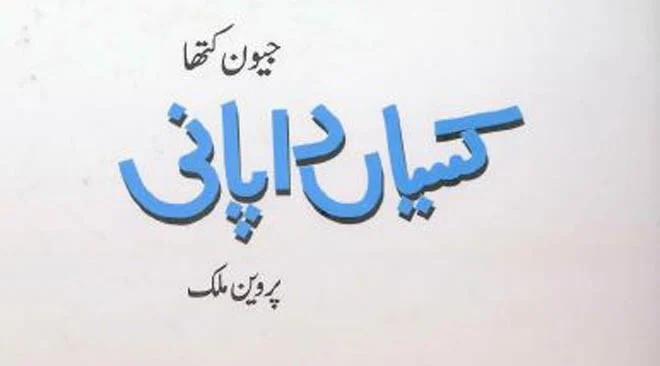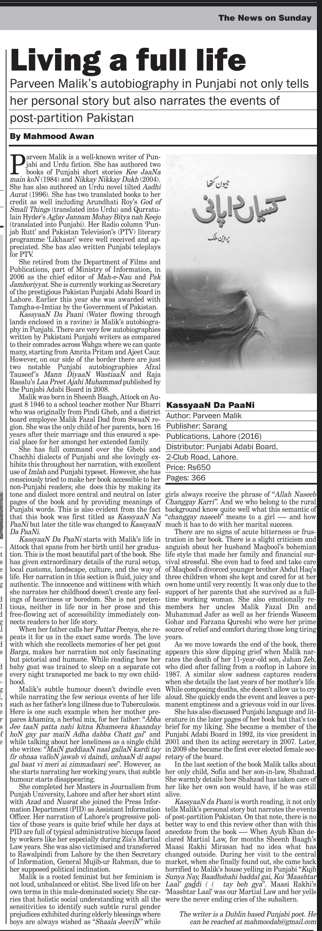Mahmood Awan (The News on Sunday, 18th June 2017)
Parveen Malik is a well-known writer of Punjabi and Urdu fiction. She has authored two books of Punjabi short stories Kee JaaNa main koN (1984) and Nikkay Nikkay Dukh (2004). She has also authored an Urdu novel tilted Aadhi Aurat (1996). She has two translated books to her credit as well including Arundhati Roy’s God of Small Things (translated into Urdu) and Qurratulain Hyder’s Aglay Jannam Mohay Bitya nah Keejo (translated into Punjabi). Her Radio column ‘Punjab Rutt’ and Pakistan Television’s (PTV) literary programme ‘Likhaari’ were well received and appreciated. She has also written Punjabi teleplays for PTV.
She retired from the Department of Films and Publications, part of Ministry of Information, in 2006 as the chief editor of Mah-e-Nau and Pak Jamhoriyyat. She is currently working as Secretary of the prestigious Pakistan Punjabi Adabi Board in Lahore. Earlier this year she was awarded with Tamgha-e-Imtiaz by the Government of Pakistan.
KassyaaN Da Paani (Water flowing through lands enclosed in a ravine) is Malik’s autobiography in Punjabi. There are very few autobiographies written by Pakistani Punjabi writers as compared to their comrades across Wahga where we can quote many, starting from Amrita Pritam and Ajeet Caur. However, on our side of the border there are just two notable Punjabi autobiographies Afzal Tauseef’s Mann DiyaaN WastiaaN and Raja Rasalu’s Laa Preet Ajahi Muhammad published by the Punjabi Adabi Board in 2008.
Malik was born in Sheenh Baagh, Attock on August 8 1946 to a school teacher mother Nur Bharri who was originally from Pindi Gheb, and a district board employee Malik Fazal Dad from SwaaN region. She was the only child of her parents, born 16 years after their marriage and this ensured a special place for her amongst her extended family.
She has full command over the Ghebi and Chachhi dialects of Punjabi and she lovingly exhibits this throughout her narration, with excellent use of Imlah and Punjabi typeset. However, she has consciously tried to make her book accessible to her non-Punjabi readers; she does this by making its tone and dialect more central and neutral on later pages of the book and by providing meanings of difficult Punjabi words. This is also evident from the fact that this book was first titled as KassyaaN Na PaaNi but later the title was changed to KassyaaN Da PaaNi.
KassyaaN Da PaaNi starts with Malik’s life in Attock that spans from her birth until her graduation. This is the most beautiful part of the book. She has given extraordinary details of the rural setup, local customs, landscape, culture, and the way of life. Her narration in this section is fluid, juicy and authentic. The innocence and wittiness with which she narrates her childhood doesn’t create any feelings of heaviness or boredom. She is not pretentious, neither in life nor in her prose and this free-flowing act of accessibility immediately connects readers to her life story.
When her father calls her Puttar Peenya, she repeats it for us in the exact same words. The love with which she recollects memories of her pet goat Barga, makes her narration not only fascinating but pictorial and humane. While reading how her baby goat was trained to sleep on a separate cot every night transported me back to my own childhood.
Malik’s subtle humour doesn’t dwindle even while narrating the few serious events of her life such as her father’s long illness due to Tuberculosis. Here is one such example when her mother prepares khamira, a herbal mix, for her father: “Abba Jee taaN patta nahi kitna Khameera khaanday hoN gay par maiN Adha dabba Chatt gai” and while talking about her loneliness as a single child she writes: “MaiN guddiaaN naal gallaN kardi tay fir ohnaa valloN jawab vi daindi, unhaaN di aapsi gal baat vi meri ai zimmadaari see“. However, as she starts narrating her working years, that subtle humour starts disappearing.
She completed her Masters in Journalism from Punjab University, Lahore and after her short stint with Azad and Nusrat she joined the Press Information Department (PID) as Assistant Information Officer. Her narration of Lahore’s progressive politics of those years is quite brief while her days at PID are full of typical administrative hiccups faced by workers like her especially during Zia’s Martial Law years. She was also victimised and transferred to Rawalpindi from Lahore by the then Secretary of Information, General Mujib-ur Rahman, due to her supposed political inclination.
Malik is a rooted feminist but her feminism is not loud, unbalanced or elitist. She lived life on her own terms in this male-dominated society. She carries that holistic social understanding with all the sensitivities to identify such subtle rural gender prejudices exhibited during elderly blessings where boys are always wished as “Shaala JeeviN” while girls always receive the phrase of “Allah Naseeb Changgay Karri”. And we who belong to the rural background know quite well what this semantic of “changgay naseeb” means to a girl — and how much it has to do with her marital success.
There are no signs of acute bitterness or frustration in her book. There is a slight criticism and anguish about her husband Maqbool’s bohemian life style that made her family and financial survival stressful. She even had to feed and take care of Maqbool’s divorced younger brother Abdul Haq’s three children whom she kept and cared for at her own home until very recently. It was only due to the support of her parents that she survived as a full-time working woman. She also emotionally remembers her uncles Malik Fazal Din and Muhammad Jafer as well as her friends Waseem Gohar and Farzana Qureshi who were her prime source of relief and comfort during those long tiring years.
As we move towards the end of the book, there appears this slow dipping grief when Malik narrates the death of her 11-year-old son, Jahan Zeb, who died after falling from a rooftop in Lahore in 1987. A similar slow sadness captures readers when she details the last years of her mother’s life. While composing deaths, she doesn’t allow us to cry aloud. She quickly ends the event and leaves a permanent emptiness and a grievous void in our lives.
She has also discussed Punjabi language and literature in the later pages of her book but that’s too brief for my liking. She became a member of the Punjabi Adabi Board in 1992, its vice president in 2001 and then its acting secretary in 2007. Later, in 2009 she became the first ever elected female secretary of the board.
In the last section of the book Malik talks about her only child, Sofia and her son-in-law, Shahzad. She warmly details how Shahzad has taken care of her like her own son would have, if he was still alive.
KassyaaN da Paani is worth reading, it not only tells Malik’s personal story but narrates the events of post-partition Pakistan. On that note, there is no better way to end this review other than with this anecdote from the book — When Ayub Khan declared Martial Law, for months Sheenh Baagh’s Maasi Rakhi Mirasan had no idea what has changed outside. During her visit to the central market, when she finally found out, she came back horrified to Malik’s house yelling in Punjabi “Kujh Sunya Nay, Baadhshahi baddal gai, Koi ‘Maashtar Laal’ gaddi ( (گدّی tay beh gya“. Maasi Rakhi’s ‘Maashtar Laal’ was our Martial Law and her yells were the never ending cries of the subaltern.
KassyaaN Da PaaNi
Author: Parveen Malik
Publisher: Sarang Publications, Lahore (2016)
Distributor: Punjabi Adabi Board, 2-Club Road, Lahore
Price: Rs650
Pages: 366
Published on 18th June 2017 in The News on Sunday.
https://www.thenews.com.pk/tns/detail/563499-living-full-life


